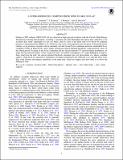A SUPER-EDDINGTON, COMPTON-THICK WIND IN GRO J1655–40?
Author(s)
Rahoui, F.; Buxton, M.; Neilsen, Joseph M. G.; Homan, Jeroen
DownloadNeilsen-2016-A super-Eddington, C.pdf (1.154Mb)
PUBLISHER_POLICY
Publisher Policy
Article is made available in accordance with the publisher's policy and may be subject to US copyright law. Please refer to the publisher's site for terms of use.
Terms of use
Metadata
Show full item recordAbstract
During its 2005 outburst, GRO J1655–40 was observed at high spectral resolution with the Chandra High-Energy Transmission Grating Spectrometer, revealing a spectrum rich with blueshifted absorption lines indicative of an accretion disk wind—apparently too hot, too dense, and too close to the black hole to be driven by radiation pressure or thermal pressure (Miller et al.). However, this exotic wind represents just one piece of the puzzle in this outburst, as its presence coincides with an extremely soft and curved X-ray continuum spectrum, remarkable X-ray variability (Uttley & Klein-Wolt), and a bright, unexpected optical/infrared blackbody component that varies on the orbital period. Focusing on the X-ray continuum and the optical/infrared/UV spectral energy distribution, we argue that the unusual features of this "hypersoft state" are natural consequences of a super-Eddington Compton-thick wind from the disk: the optical/infrared blackbody represents the cool photosphere of a dense, extended outflow, while the X-ray emission is explained as Compton scattering by the relatively cool, optically thick wind. This wind obscures the intrinsic luminosity of the inner disk, which we suggest may have been at or above the Eddington limit.
Date issued
2016-04Department
MIT Kavli Institute for Astrophysics and Space ResearchJournal
The Astrophysical Journal
Publisher
IOP Publishing
Citation
Neilsen, J. et al. “A SUPER-EDDINGTON, COMPTON-THICK WIND IN GRO J1655–40?” The Astrophysical Journal 822.1 (2016): 20. © 2016 The American Astronomical Society.
Version: Final published version
ISSN
1538-4357
0004-637X